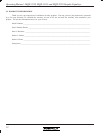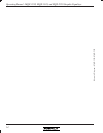
9
Operating Manual - MQX-2310, MQX-1310, and MQX-2150 Graphic Equalizer
when this filter type is combined with a potentiometer to
adjust the equalization, the resistance of this pot affects
the “Q” of the filter so that a little equalization produces
a much broader curve than a lot of equalization.
The other filter approach is a true bandpass fil-
ter. This can be made with no inductors and more practi-
cal sized capacitors; the “Q” is easily set and remains
constant, and the parts count is reasonable. there are sev-
eral types of bandpass filters suitable for this job. Ashly
uses a “Q” enhanced Wein-bridge filter. Because it is a
symmetrical design using matched tuning components, the
“Q” is easily set and is very stable.
In designing a graphic equalizer, a selection of
filter sharpness must be made. More sharpness (higher
Q) produces less filter overlap and tighter control over an
individual band, but also causes ripple in the frequency
response when many filters are boost or cut together to
produce a flat response. We feel that the graphic
equalizer’s primary use is for “voicing” and tone control,
and have set our filter sharpness to produce a maximum
of 1dB ripple.
The summing system in a graphic equalizer is
also important. Since there are a number of filters which
combine to produce the overall response, it is important
that the filters not interact (they WILL overlap, but the
response of one filter should not modify the response of
another). Ashly uses an “interleaved” summing system
where every other filter uses the same summing ampli-
fier so that adjacent filters never share the same drive
and feedback signals. This allows the filters to maintain
their natural response.
9. TROUBLESHOOTING TIPS
9.1 No Audio Output
Check AC power - is the pilot light on?
Check in/out connections - are they reversed?
Are you sure you have an input signal?
9.2 EQ Controls Do Nothing
Is the master EQ switch in?
The lowest and highest frequency sliders may be
beyond the range of the program material or speakers and
may produce little or no audible effect.
9.3 Peak Light Flashes or Stays On All the Time
If the peak light flashes, the signal level to the
equalizer is too high. Turn down the gain. If it is on all
the time, disconnect the input and output cables. If it is
still on, the unit must be returned for service.
9.4 Distorted Sound
This will only be caused by too much signal
which will show on the Clip LED. If the LED is not
flashing, there is an overload somewhere else in the sig-
nal path. Adjust the relative gain of each component in
your chain to keep everything at a comfortable level.
9.5 Excessive Hum or Noise
Hum will usually be caused by a ground loop be-
tween components. Try using the suggested balanced in-
put and output hook-ups if the other pieces of equipment
used in conjunction with your equalizer have balanced
inputs and outputs.
Noise (excessive hiss) can be caused by insuffi-
cient drive signal. Make sure you are sending a nominal
0 dBu line level signal to the equalizer. Most noise prob-
lems occur because gain is applied to audio signals too
late in the chain. For best performance, apply gain to
individual source signals as early as possible, like at the
mixer input section. As gain increases, it also boosts the
noise content of that signal. Any cumulative noise built
up in a mixed signal will only be increased by using an
equalizer as a gain device, so make every attempt to op-
erate the equalizer with as little gain as possible.
Note: Unshielded cables, improperly wired con-
nections, and cable with broken strands (shorts, etc.) are
the most common problems. Make sure you use good
quality cable with connectors soldered firmly on the cor-
rect pin. When in doubt, get in touch with your Ashly
dealer, or call the Ashly service department at 800-828-
6308 ext.125.


















